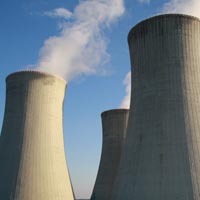
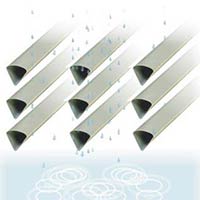
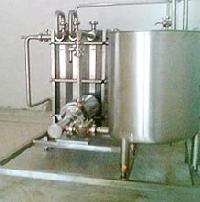

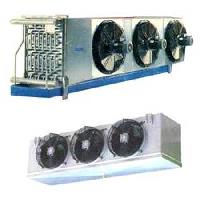
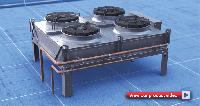
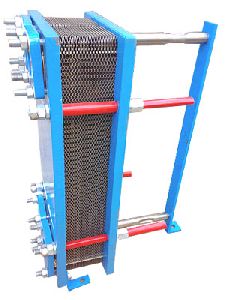
Plate Heat Exchangers
Get Price Quote
We manufacture and supply highest quality range of plate heat exchanger using the most advanced technology for a wide series of heat transfer applications used in various industries such as chemical industry, offshore, oil and gas, petrochemicals power plants, pulp and paper, steel, zinc and aluminium, sugar, vegetable oil, breweries / distilleries, dairy / beverages and others. The difference lies at plate design, sealing technology, capacity range, product range etc. We always continue to improve our Plate heat exchanger to give total customer's satisfaction. Plate Heat Exchanger Features High heat transfer coefficients Optimized heat recovery Compact constructions No mixing of product Flexibility to change plate arrangement and to add / remove plate Easy maintenance and suitable for CIP, plate pack easily accessible. Plate Heat Exchanger A plate type heat exchanger is a type of heat exchanger that uses metal plates to transfer heat between two fluids. This has a major advantage over a conventional heat system in that the fluids are exposed to a much larger surface area because the fluids spread out over the plates. This facilitates the transfer of heat, and greatly increases the speed of the temperature change. It is not as common to see plate heat exchangers because they need well-sealed gaskets to prevent the fluids from escaping, although modern manufacturing processes have made them feasible. Plate Frame Heat Exchanger Application Plate Frame Heat Exchanger Cleaning Plate and Frame Heat Exchangers Animation Plate and Frame Heat Exchanger Approach Plate finned type Heat Exchanger Brazed Plate Heat Exchangers Plate Heat Exchanger Design The concept behind a plate heat exchanger is the use of pipes or other containment vessels to heat or cool one fluid by transferring heat between it and another fluid. In most cases, the exchanger consists of a coiled pipe containing one fluid that passes through a chamber containing another fluid. The walls of the pipe are usually made of metal, or another substance with a high thermal conductivity, to facilitate the interchange, whereas the outer casing of the larger chamber is made of a plastic or coated with thermal insulation, to discourage heat from escaping from the exchanger. The plate heat system (PHE) s was invented by Dr Richard Seligman in 1923 and revolutionized methods of indirect heating and cooling of fluids. Plate exchanger one is composed of multiple, thin, slightly-separated plates that have very large surface areas and fluid flow passages for heat transfer. This stacked-plate arrangement can be more effective, in a given space, than the shell and tube heat system. Advances in gasket and brazing technology have made the plate type heat system increasingly practical. In HVAC applications, large exchangers of this type are called plate-and-frame; when used in open loops, these heat system are normally of the gasket type to allow periodic disassembly, cleaning, and inspection. There are many types of permanently-bonded plate heat system, such as dip-brazed and vacuum-brazed plate varieties, and they are often specified for closed-loop applications such as refrigeration. Plate heat systems also differ in the types of plates that are used, and in the configurations of those plates. Some plates may be stamped with "chevron" or other patterns, where others may have machined fins and/or grooves. Liquid foods such as milk, fruit juices, beers, wines, and liquid eggs are pasteurized using plate-type. Wine and fruit juices are normally deaerated prior to pasteurization in order to remove oxygen and minimize oxidative deterioration of the products. Plate Type heat exchanger consist of a large number of thin, vertical steel plates that are clamped together in a frame. So it may called as Plate and Frame. We manufacture Plate Heat Exchanger that are used in dairy, pharma and biotechnology, beverages, brewery, chemical and power sectors. PHE plates are available in MOC AISI 304, AISI 316, AISI 316L, Titanium, Hast alloy, Monel in range thickness from 0.5mm to 0.9mm. It is suitable for handling fluid from 100 LPH to 3.5 Million LPH. The plate heat exchanger sare available in herring bone, free flow and semi welded construction and depending on application respective plates are selected. Plate heat exchangers - Bolted design (plate and frame) Heat transfer plates are characterized by optimum embossing resulting in high heat transfer coefficients. This permits low-cost and optimum adoption to the respective application conditions Our product range includes single-pass and multi-pass plate heat exchangers with heat exchange surface up to 1500 m². Plate Heat Exchanger Technical data: heat exchange surface per plate: 0,04 - 2,50 m² max. design pressure: 25 bar max. design temperature: 170°C Plate Heat Exchanger Safety:Our plates are provided with double gaskets at the inlet and outlet which prevent mixing of the two media. If designed as safety heat exchanger, double plates are provided with a special sealing system. Plate material: standard: stainless steel 1.4301/AISI 304, 1.4401/AISI 316 optionally: 1.4539, 254 SMO, titanium Gasket material: NBR (nitrile-rubber) EPDM (ethylene-propylene-rubber) Viton (fluorine-rubber) Further materials on request Special series: Safety heat exchangers (FPSS) Stainless steel design for food and FDA applications Compact double PHE-units including cocks and valves Design with welded cassettes (FPG)

Plate finned type Heat Exchanger
Get Price Quote
Plate finned type Heat Exchanger of flexibility is present in plate-fin heat exchanger design as they can operate with any combination of gas, liquid, and two-phase fluids.
Best Deals from Plate Heat Exchangers
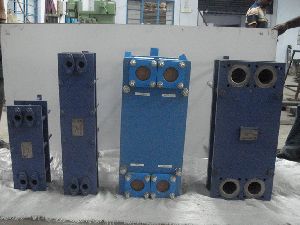
Plate Type Heat Exchanger
Get Price Quote
A plate type heat exchanger is a type of heat exchanger that uses metal plates to transfer heat between two fluids. This has a major advantage over a conventional heat exchanger in that the fluids are exposed to a much larger surface area because the fluids spread out over the plates. This facilitates the transfer of heat, and greatly increases the speed of the temperature change. It is not as common to see plate heat exchangers because they need well-sealed gaskets to prevent the fluids from escaping, although modern manufacturing processes have made them feasible. The concept behind a heat exchanger is the use of pipes or other containment vessels to heat or cool one fluid by transferring heat between it and another fluid. In most cases, the exchanger consists of a coiled pipe containing one fluid that passes through a chamber containing another fluid. The walls of the pipe are usually made of metal, or another substance with a high thermal conductivity, to facilitate the interchange, whereas the outer casing of the larger chamber is made of a plastic or coated with thermal insulation, to discourage heat from escaping from the exchanger. The plate heat exchanger (PHE) was invented by Dr Richard Seligman in 1923 and revolutionized methods of indirect heating and cooling of fluids. Plate type heat exchanger one is composed of multiple, thin, slightly-separated plates that have very large surface areas and fluid flow passages for heat transfer. This stacked-plate arrangement can be more effective, in a given space, than the shell and tube heat exchanger. Advances in gasket and brazing technology have made the plate-type heat exchanger increasingly practical. In HVAC applications, large heat exchangers of this type are called plate-and-frame; when used in open loops, these heat exchangers are normally of the gasket type to allow periodic disassembly, cleaning, and inspection. There are many types of permanently-bonded plate heat exchangers, such as dip-brazed and vacuum-brazed plate varieties, and they are often specified for closed-loop applications such as refrigeration. Plate heat exchangers also differ in the types of plates that are used, and in the configurations of those plates. Some plates may be stamped with “chevron” or other patterns, where others may have machined fins and/or grooves. Specifications : Liquid foods such as milk, fruit juices, beers, wines, and liquid eggs are pasteurized using plate-type heat exchangers. Wine and fruit sjuices are normally deaerated prior to pasteurization in order to remove oxygen and minimize oxidative deterioration of the products. Plate-type heat exchangers consist of a large number of thin, vertical steel plates that are clamped together in a frame. Applications : The plates produce an extremely large surface area, which allows for the fastest possible transfer. Making each chamber thin ensures that the majority of the volume of the liquid contacts the plate, again aiding exchange. The troughs also create and maintain a turbulent flow in the liquid to maximize heat transfer in the exchanger. A high degree of turbulence can be obtained at low flow rates and high heat transfer coefficient can then be achieved. Advantages : Easy maintenance and suitable for CIP, plate pack easily accessible High heat transfer coefficients Flexibility to change plate arrangement and to add or remove plate No mixing of product Compact constructions Optimized heat recovery

Plate finned type Heat Exchanger
Get Price Quote
Plate finned type Heat Exchanger in India. A plate-fin heat exchanger is a type of heat exchanger design that uses plates and finned chambers to transfer heat between fluids. It is often categorized as a compact heat exchanger to emphasise its relatively high heat transfer surface area to volume ratio. The plate-fin heat exchanger is widely used in many industries,
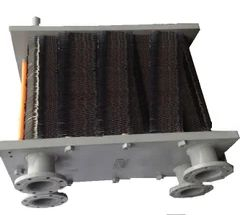
Plate Heat Exchanger
15,000 Per Piece
1 Piece (MOQ)
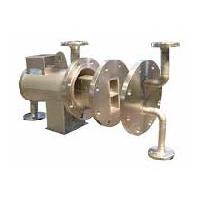
Conventional Plate Heat Exchanger
Get Price Quote
We are among the leading Manufacturers, Suppliers and Exporters of Conventional Plate Heat Exchanger to the esteemed clients. These Conventional Plate Heat Exchangers are available in various types� Water Jacket Type, Fins Type and U Tube Type. These Conventional Plate Heat Exchangers are suited for aviation and aerospace applications, including engine cooling. These Conventional Plate Heat Exchangers are procured from reliable Vendors in the market and advanced technology. These Conventional Plate Heat Exchangers are available at competitive rates in the market. A Plate Type Heat Exchanger is a type of Heat Exchanger that uses metal plates to transfer heat between two fluids. This has a major advantage over a Conventional Heat Exchanger in that the fluids are exposed to a much larger surface area because the fluids spread out over the plates. This facilitates the transfer of heat, and greatly increases the speed of the temperature change. It is not as common to see Plate Heat Exchangers because they need well-sealed gaskets to prevent the fluids from escaping, although modern manufacturing processes have made them feasible. Technical Data Heat exchange surface per plate : 0. 04 � 2. 50 m²Max. Design pressure : 25 barMax. Design temperature : 170oCPlate Material : 304, 316L, 310S, 254MO, C-276, TA1, N6 Applications Heat Exchangers are suited for aviation and aerospace applications including engine coolingIn automotive or industrial truckFor heating and cooling water for domestic purpose (e.g. swimming pools, snow melting, and boilers)Designed to cool electronic components that generate high amount of heat (CPUs, Lasers, and Transformers)In food, Dairy and brewing industriesFor heating, ventilation and air conditioning (HVAC) applicationsFor Heating and cooling of hydraulic power fluidFor Oil heating and cooling applicationsSuited for marine or shipboard applicationsSuited for power generation applicationsFor compressed air and are designed for use in pneumatic systemsFor use with refrigerants in cooling systemsSuited for applicants that involve the transfer of heat to and from steamOther unlisted or specialized applications

Plate Heat Exchanger
Get Price Quote
JC Equipments are leading designing and manufacture the Plate heat exchanger in india and the types are (Gasketed Plate, Copper-brazed Plate, Fully-welded Plate, Semi-welded Plate). PHE are used commonly at the same time as average of heat exchange across various plants and industries, and we having more than 23 years of experience in this field. Plate types (M6, M6-M and M6-MD).

Plate finned type Heat Exchanger
Get Price Quote
We manufacture and export all types of industrial heat exchanger in INDIA. The heat exchangers are commonly useful in industries where the fluids have small chances of fouling. Our heat exchangers can be made in a various of materials. plate fin heat exchanger manufacture are the same for all sizes and all materials. Plate finned type Heat Exchanger Flow Types are Parallel flow, Counter flow and Cross flow. Plate finned type Heat Exchanger Material of Construction : Stainless steel casings, Copper Alloy tubes, Aluminum Fins or Foils, Copper Tubes, Carbon steel Casings Plate Finned Type Heat Exchanger Applications Refrigeration Condensers Air Coolers Air Heaters Natural gas liquefaction Air Separation Steam Condensers Ammonia production Oil refineries Food Industries and Processing Industries Nuclear engineering Syngas production Aluminium Plate Finned Heat Exchangers : The heat exchangers are developed by vacuum brazing technology and the heat exchangers as single units or as manifolded assemblies, isothermal reactors for chemical Plants and Coil wound heat exchangers and petrochemical industry plants. Plate Finned Heat Exchangers Comparison with Shell and Tube Heat Exchanger. A Plate finned heat exchanger with 6 fins/cm provides approximately 1,300 m2 of surface per m3 of volume. This heat exchanger would be approximately 10% of the volume of an equivalen shell and tube heat exchanger with 9 mm tubes.

Plate Type Heat Exchanger
Get Price Quote
Plate heat exchangers have a high heat transfer rate compared to other types of heat exchangers due to their large surface area. They are composed of a number of thin metal plates compressed together into a ‘plate pack’ by two pressure plates. Within a plate heat exchanger, the fluid paths alternate between plates allowing the two fluids to interact, but not mix, several times in a small area. Each plate is corrugated to increase the surface area and maximize heat transfer. plate heat exchangers have a number of applications in the pharmaceutical, petrochemical, chemical, power, industrial dairy, and food & beverage industry.

Plate Heat Exchanger
Get Price Quote
We are counted among the most prominent Plate-Type Heat Exchanger Exporters from Tamil Nadu. Our Plate Heat Exchanger comprises of various corrugated metal plates with holes between the two fluids through which transfer of heat can take place. Herein, the sizes and number of the plates are determined by the physical properties of the fluids, flow rate, temperature program, and pressure drop. With efficient manufacturing capabilities, we are able to offer customized designs of Industrial Plate Heat Exchanger as per the need of the client.

Plate Fin Heat Exchanger
Get Price Quote
We are offering Plate fin heat exchanger is one of the most efficient compact heat exchanger. The gaps between constitute a fluid layer. A core is made of a great number of layers. The exchanger can be made of one or more cores. The number of plate and fin layers, the size of the plates and fin, the height of the fin and the type of fin are engineered for optimum performance. The core is assembled (stacked) and typically held together by tack welding a weld rod to the top and bottom layer of the core. The stacked core is then placed within a fixture that exerts force on the individual pieces to keep them in contact. The part is then vacuum brazed in an environmentally-controlled room to ensure high quality and reliability. After brazing the core is typically heat treated or aged in order to increase its strength. Manifold ducting and mounting brackets are then welded in place as required, and any required paint or coating can be added.

Plate Heat Exchangers
1 Per -

Plate Type Heat Exchanger
Get Price Quote
Plate Type Heat Exchanger, Natural Draft Cooling Tower